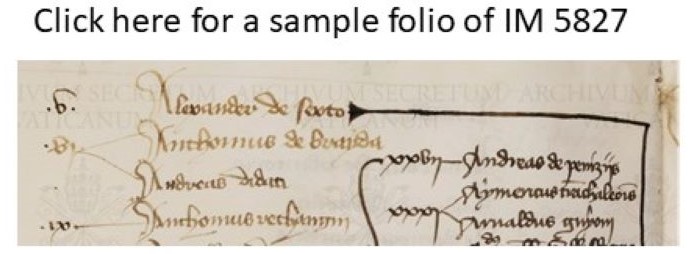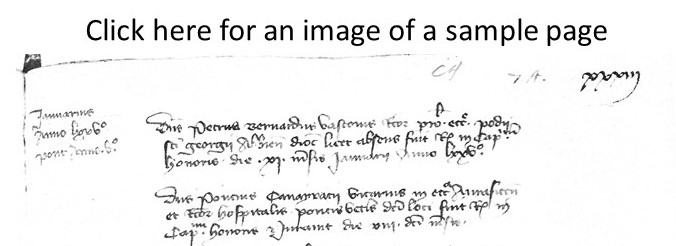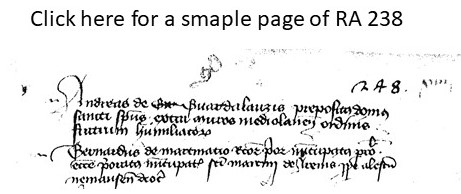Registra Avenionensia 238
Liber parvus, RA 238
RA 238, 235r-272r (j-xxxviij) called the Liber parvus. This volume contains seven lists of papal honorary chaplains from the pontificates of Urban V and Gregory XI and the first six years of Clement VII. It was created some time after mid-June 1384 at the beginning of the tenure of François de Conzié as chamberlain, and archived by being bound up with the paper register of papal letters for 1383-1384. It was meant to capture the information from all known source lists and registers, other than RA 173, of the names and circumstances of chaplains of honor from the two previous papacies and from Clement VII’s up to that time, in order to complete the memorial of names in RA 173’s master list. Of the 383 names recorded in the Liber Parvus, 222 in fact are not found in RA 173.Back to the top of the Archival Sources page
We divide the Liber Parvus into three sections which we designate A, B and C. Each begins with Urban’s chaplains and continues with Gregory’s. A and B also report lists of chaplains from the time of Clement VII.
Section A: 235r-242v (j-viij) Lists of honorary chaplains created by each of the popes. These records are divided by year but not more precisely dated. Each gives the full name of the chaplain and his benefice and its diocese.
- 235r-236r, titled Sequntur nomina capellanorum factorum per dominum Urbanum papam quintum: 25 names.
- 236r-240r, Isti qui sequntur sunt de tempore domini Gregorii //pape XImi\\: 113 names.
- 240r-242v, Sequntur nomina capellanorum per dominum Clementem papam septimum factorum, ending in the sixth year of his pontificate (Sep. 20 1383-Sep19, 1384): 71 names
Section B: 243r-255v (ix-xxj) This section includes five lists, each distinguished by the name of the clerk who kept the list or the source of the list. The first list from the register of H. Bayler includes names from Urban V, Gregory XI and the first six years of Clement VII. The four other lists in Section B all date from the first six years of the pontificate of Clement VII. Their named sources indicate the range of possible uncollated lists. The full dates of the entries recorded by Pontius Beraldi and Johannes de Neapoli, the second and third lists in Section B, give a terminus post quem of mid-June 1384 for the compilation of the Liber Parvus. 1
- 243r-251v, Sequntur nomina capellanorum honoris tam de tempore domini Urbani quinti quam domini Gregorii XI et domini moderni Clementis septimi, repertorum in registro magistri H. Bayler. These lists are dated by year only and usually give the name of the chaplain, his benefice and its location.
- 243r-243v for Urban V, 23 names
- 243v-249r for Gregory XI, 181 names
- 249r-251v for Clement VII, 76 names
- 251v-252r, Sequntur cappellani honoris quorum littere sunt michi Pontio Beraldi commisse, 18 names. These records include the full day, month and year, 15 March 1379 to 14 June 1384, as well as name, benefice and location. Beraldi was a corrector of Papal letters.
- 252v-254r, Cappellani honoris mei Johannis de Neapoli, 45 records with full dates from 10 February 1381 to 5 June 1384.
- 254v, Nomina Cappellanorum honoris Reperta in registris Magistri Gilberti de Tadinghem domini nostri pape secretarii, 16 entries without dates give the name, benefice and location.
- 255rv Infrascripti fuerunt recepti in cappellanos honoris dicti Domini nostri Clementis pape septimi et sedis apostolice prout constat per bullas dicti domini nostri de regestro ad cameram apportatas, 9 entries giving the chaplain’s name, benefice and location, with full day, month and year from 13 August 1379 to 12 July 1382.
- 256rv, blank.
Section C: 257r-272r (xxiij-xxxviij) reports a final set of records copied from cameral registers, most of them directly from Coll. 358. They report the full date of the reception, the name of the new chaplain, his title and benefice and diocese, and details of the reception and oath or commission to receive the oath.
- 257r-259v, 29 records from years 1362, 1368 and 1369 of the pontificate of Urban V.
- 259v-261r, 28 records mostly from the first months of Gregory XI’s reign and the last months of Aubert’s life, but with with stray records from later and two from Urban V’s pontificate by mistake.
- 261r-271v, the compliers of the Liber Parvus accurately copied the 116 records from 1371 to 1373 in the chamberlain’s Coll. 358. That list ends with the five mostly duplicate records from Coll. 358, 189r.
- 271v-272r, the compilers of the Liber Parvus added 5 records not found in Coll. 358. It may be that these records had been lost from Coll. 358 since they immediately follow the last misplaced records from Coll. 358.

Instrumenta Miscellania 5827
Alphabetical Index, IM 5827
IM 5827 contains a series of indices, divided by pontificates from John XXII to Clement VII, of the forenames and surnames of the
capellani honoris.
Each index is in the alphabetical order of the first letter (only) of forenames, each name with a reference in minuscule roman numbers.
Charles Burns 2
discovered that IM 5827 is an index to several registers of honorary chaplains and he identified the manuscript registers to which those references were
intended to lead. The targets of the Gregory XI index on folios 23v-38v are RA 173 and RA 238, the Liber parvus. For
Gregory XI there were 871 names,
according to Guillemain; but when these were laid out on the Excel spreadsheet and the duplicate and triplicate entries were reduced, there remained 641
names. Thirty names which occur in the target lists, scattered over the years, are missing from the index by mistake. The orthography of the Latin
forenames has been regularized in the spreadsheet so that it can be sorted alphabetically.
As Burns surmised3, the names were entered by one clerk as they were read by another; this accounts for the misspellings
and misreadings from one
source to another. The reading clerk scanned down RA 173 (and then RA 238) page by page, picking out the names beginning with each
letter in turn.There
was no attempt to collate the sources to eliminate the many duplicate names. The reader missed some names and misplaced some. Most of those slips in the
index can be understood by a look at the placement of the names in the document that was being indexed to see how the reader lost his place. For example
at the opening 80v,81r (xxxix,xl), the reader looking for names beginning with “A” turned over two leaves and searched xlii recto thinking he was
on xli
recto. The two “A” names on xlii are entered with the wrong folio number xli, and the two “A” names on folio xli are skipped.
It is possible that the index records from RA 173 were copied from a previous alphabetical list compiled the same way but created earlier,
at the end
of or during the pontificate of Gregory XI. The list as we have it in IM 5927 was created from RA 173 (or that possible earlier index)
and from the
Liber parvus at the same time: the index scribe’s hand clearly remains the same as the index switches from one source to the other, although
the hand clearly changes at other places, as another scribe takes over or the reader and writer switch roles.
There is a slight indication that the names from RA 238, Liber parvus section C may have been added as an afterthought: several of
the one-column lists of names flow into a second column at the bottom of the Liber parv3us entries, as if the next letter had been started
and more names beginning with the previous letter needed to be added.4
At letter “P” impatience or fatigue caught up with the scribes. “P” names begin toward the bottom of folio 33v and after four full folios the
last “P” name from Liber parvus section C heads folio 36r, but a line of capital “P”s runs down the page, prepared by the
scribe who had misjudged the
number of “P” names to come. Also at “P” with few exceptions the scribes were content to let a capital “P” alone stand for
Petrus, Paulus, Pontius,
Philippus and even Perpinianus, without writing those names out. This contrasts with their usual careful practice. Common names like
Guillemus,
Iohannes
and Iacobus were frequently highly abbreviated (“G.”, "Io.”, “Ia.”) but clearly differentiated from other “G” and
“I” names.They even made a careful
distinction between Guillelmus under “G” and “Willelmus” under “U, V and W”. In one instance they entered the
uncommon name “Ieminus” under “I” as
spelled in their source, but thinking of the use of the register to find a spoken name they added it again, out of order, at the end of the “G”s as
Geminus.
The index IM 5827 assures us that we have found all of the names of chaplains of honor created during the pontificate of Gregory XI
and known to the cameral staff in 1384.
______________
1Charles Burns traced one entry from Section A, that of Andreas Corderii, to the same time frame, 16 June,
1384. Burns' number 70, p. 85. “Vatican Sources and the Honorary Papal Chaplains of the Fourteenth Century,”
in Erwin Gatz, ed., Römische Kurie. Kirchliche Finanzen. Vatikanisches Archiv. Studien zu Ehren von Hermann Hoberg; Pontificia Universitas Gregoriana,
Miscellanea Historiae Pontificiae 45 (Roma, 1979) 65-95.
2 Burns studied IM 5287, concluded that it was a volume of indices, and discovered the records
to which they refer, including RA 173 and RA 238
3 Burns, p. 66
4 The affected letters are A, B, G, N (with O also appended); R, T; and the single grouping
for U, V, W (to which X is appended).

